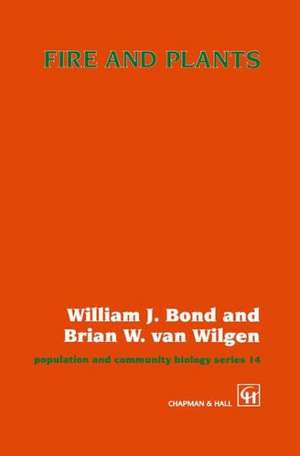Fire and Plants: Population and Community Biology Series, cartea 14
Autor William J. Bond, B.W. van Wilgenen Limba Engleză Hardback – 31 dec 1995
| Toate formatele și edițiile | Preț | Express |
|---|---|---|
| Paperback (1) | 1215.85 lei 6-8 săpt. | |
| SPRINGER NETHERLANDS – 28 sep 2011 | 1215.85 lei 6-8 săpt. | |
| Hardback (1) | 1045.08 lei 38-45 zile | |
| SPRINGER NETHERLANDS – 31 dec 1995 | 1045.08 lei 38-45 zile |
Din seria Population and Community Biology Series
- 15%
 Preț: 646.11 lei
Preț: 646.11 lei - 18%
 Preț: 1224.54 lei
Preț: 1224.54 lei -
 Preț: 404.51 lei
Preț: 404.51 lei -
 Preț: 381.98 lei
Preț: 381.98 lei -
 Preț: 396.62 lei
Preț: 396.62 lei -
 Preț: 393.13 lei
Preț: 393.13 lei -
 Preț: 382.95 lei
Preț: 382.95 lei - 5%
 Preț: 373.47 lei
Preț: 373.47 lei - 18%
 Preț: 1221.38 lei
Preț: 1221.38 lei - 18%
 Preț: 1224.36 lei
Preț: 1224.36 lei -
 Preț: 383.71 lei
Preț: 383.71 lei - 24%
 Preț: 1033.06 lei
Preț: 1033.06 lei - 18%
 Preț: 1228.62 lei
Preț: 1228.62 lei - 18%
 Preț: 1546.05 lei
Preț: 1546.05 lei - 18%
 Preț: 959.98 lei
Preț: 959.98 lei - 18%
 Preț: 953.65 lei
Preț: 953.65 lei - 15%
 Preț: 635.80 lei
Preț: 635.80 lei - 18%
 Preț: 950.52 lei
Preț: 950.52 lei - 18%
 Preț: 834.17 lei
Preț: 834.17 lei - 15%
 Preț: 644.95 lei
Preț: 644.95 lei -
 Preț: 405.66 lei
Preț: 405.66 lei -
 Preț: 391.99 lei
Preț: 391.99 lei - 18%
 Preț: 1236.19 lei
Preț: 1236.19 lei - 15%
 Preț: 637.78 lei
Preț: 637.78 lei -
 Preț: 383.93 lei
Preț: 383.93 lei -
 Preț: 397.38 lei
Preț: 397.38 lei - 15%
 Preț: 640.06 lei
Preț: 640.06 lei
Preț: 1045.08 lei
Preț vechi: 1375.10 lei
-24% Nou
Puncte Express: 1568
Preț estimativ în valută:
199.97€ • 208.79$ • 165.51£
199.97€ • 208.79$ • 165.51£
Carte tipărită la comandă
Livrare economică 31 martie-07 aprilie
Preluare comenzi: 021 569.72.76
Specificații
ISBN-13: 9780412475405
ISBN-10: 0412475405
Pagini: 263
Ilustrații: VIII, 263 p.
Dimensiuni: 155 x 235 x 17 mm
Greutate: 0.56 kg
Ediția:1996
Editura: SPRINGER NETHERLANDS
Colecția Springer
Seria Population and Community Biology Series
Locul publicării:Dordrecht, Netherlands
ISBN-10: 0412475405
Pagini: 263
Ilustrații: VIII, 263 p.
Dimensiuni: 155 x 235 x 17 mm
Greutate: 0.56 kg
Ediția:1996
Editura: SPRINGER NETHERLANDS
Colecția Springer
Seria Population and Community Biology Series
Locul publicării:Dordrecht, Netherlands
Public țintă
ResearchCuprins
1 Introduction.- 1.1 The global importance of fire.- 1.2 Why we have written this book.- 1.3 What this book is about.- 1.4 Methods of fire ecology.- 1.5 Ecological concepts and fire ecology.- 1.6 Fire and the ecology of plants.- 2 Why and how do ecosystems burn?.- 2.1 The fire regime.- 2.2 Prerequisites for fire.- 2.3 Plants as ‘fuel’: what makes vegetation flammable?.- 2.4 Fire recurrence intervals and their measurement.- 2.5 Temperature of fires and survival of plant tissues.- 2.6 Conclusions.- 3 Surviving fires — vegetative and reproductive responses.- 3.1 Vegetative survival.- 3.2 The post-burn environment as reproductive stimulus.- 3.3 Reproduction and fire.- 3.4 Fire life-histories.- 3.5 Conclusions.- 4 Plant demography and fire I. Interval-dependent effects.- 4.1 Introduction.- 4.2 Types of population growth.- 4.3 Modelling populating growth.- 4.4 Demography and the fire-interval hypothesis.- 4.5 Density dependence and population regulation — the self-regulatory hypothesis.- 4.6 Event-dependent dynamics and population regulation.- 4.7 Conclusion.- 5 Plant demography and fire II. Event-dependent effects.- 5.1 Introduction.- 5.2 Effects of fire intensity and season on survival.- 5.3 Effects of fire intensity and season on recruitment.- 5.4 Effects of climate variation on recruitment.- 5.5 Effects of ground fires.- 5.6 Effects of fire area.- 5.7 The causes of event-dependent effects.- 5.8 Explaining survival patterns.- 5.9 Explaining recruitment patterns.- 5.10 Predicting event-dependent effects.- 5.11 Event-dependent effects in different biomes.- 5.12 Conclusions.- 6 Fire and the evolutionary ecology of plants.- 6.1 Fire and the evolution of plant traits.- 6.2 Sprouters versus non-sprouters.- 6.3 Life-history evolution.- 6.4 Timing of reproduction andrecruitment.- 6.5 Evolution of fire-survival traits.- 6.6 Evolution of flammability.- 6.7 Conclusions.- 7 Fire, competition and the organization of communities.- 7.1 Introduction.- 7.2 What determines changes in plant communities over time?.- 7.3 What determines spatial patterns in communities?.- 7.4 Which combinations of species occur together and why?.- 7.5 Determinants of species diversity.- 7.6 Which rules for which communities?.- 7.7 Conclusions.- 8 Fire and management.- 8.1 Introduction.- 8.2 Fire as a versatile management practice.- 8.3 Predicting the ecological effects of fire.- 8.4 Managing fires.- 8.5 Conclusions.- 9 Fire and the ecology of a changing world.- 9.1 Introduction.- 9.2 Climate, fire and biogeography.- 9.3 Changing patterns of fire in modern landscapes.- 9.4 Ecological consequences of changing fire regimes.- 9.5 Conclusions.- References.- Species Index.

















